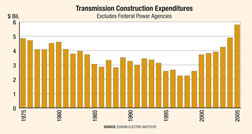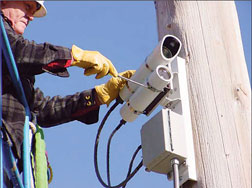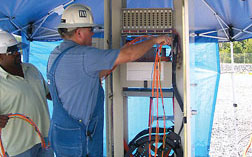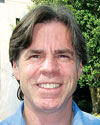NASA Video
Summer has ended without a major electricity failure. But memories of the Aug. 14, 2003, blackout in the northeastern U.S. and Canada are still fresh. Concerns about the deterioration of the U.S. infrastructure were revived by the Aug. 1 collapse of an Interstate bridge in Minnesota with the loss of 13 lives and the earlier explosion of a utility steam line in Midtown Manhattan.
The 2003 blackout was not an infrastructure failure.
| + click to enlarge |
 Nancy Soulliard Advanced sensors, using RFID technology, are in development and soon will be demonstrated in the field. Operating like an E-Z Pass toll booth, they can be read by fast-moving vehicles. |
| + click to enlarge |
 |
Since 2003, regulatory reform and research and the development and deployment of new technologies have focused on keeping the nation's lights on while demand has surged. There has been great progress in addressing the problems of the North American grid. But heading off future reliability problems will require swift adoption of new technologies being developed for system operation and rapid expansion of the transmission grid to meet the challenges of a continent-wide electricity market.
| + click to enlarge |
 Nancy Soulliard The RFID tags "backscatter" with data signals in response to excitation signals from helicopters or trucks, greatly simplifying and expediting inspections. |
The 2005 report card by the American Society of Civil Engineers judged both the overall state of U.S. infrastructure and the condition of the electric-power grid poor, giving each a grade of D. "The U.S. power transmission system is in urgent need of modernization," said the ASCE report. "Growth in electricity demand and investment in new powerplants has not been matched by investment in new transmission facilities. Maintenance expenditures have decreased 1% per year since 1992.
 Electric Power Research Institute
|
Utilities hesitated to invest in transmission because industry restructuring made recovery uncertain, ASCE noted. The situation is aggravated because "the existing system was built [by geographically separated utilities] for local needs and is struggling to meet the demands of a global system brought about by deregulation."
 Electric Power Research Inst.
|
 |
| MANSOOR |
Construction expenditures for transmission have trended down for more than two decades, according to Edison Electric Institute, Washington, D.C., the trade group representing investor-owned utilities. From $4.85 billion in 1975, in constant 2004 dollars, expenditures fell to $2.25 billion in 1997, leveled off for a year and then edged upward in 1999. But between 2000 and 2005, investment totaled $26.3 billion, jumping 8.7% in 2003, 15.5% in 2004 and 18% in 2005, say EEI officials. Now, U.S. Energy Information Administration forecasts demand growth of 1.4% per year and annual generation capacity growth of 0.8% between 2005 and 2030.
 Electric Power Research Institute A video sagometer on a structure (top) is aimed at a target on the conductor (left). Sensors can be installed on splices on energized lines.
|
"Our surveys indicate that the industry has been investing and will continue to invest in the nation's transmission infrastructure at levels not seen in 30 years," said David K. Owens, EEI executive vice president, to the Wall Street financial community at EEI's annual "state of the industry" presentation early this year.
Transmission investment through 2009 will total $31.5 billion, "nearly a 60% increase over the amount invested from 2002 to 2005," Owens said, adding that electric utility spending on distribution systems has followed a generally steady upward trend for the past 20 years and shows no sign of diminishing.
Distribution outlays will average $13 billion to $14 billion per year for the next 10 years, he projected. A Jan. 23 report from brokerage house A.G. Edwards & Sons Inc., St. Louis, also foresaw growth in transmission investment.
 Tennessee Valley Authority Fiber-optic communications are being built into TVA's Bradley substation now under construction. The system will convey data on the substation's equipment from sensors to the operation and maintenance staff.
|
Sources credit the Energy Policy Act of 2005, a vast overhaul of the U.S. energy system, for much of the turnaround. In the bulk-power system alone, the legislation repealed the law that had regulated the electric utility industry since 1935, removed many obstacles to siting of transmission lines, reformed rates and taxes to promote transmission investment, provided for the creation of an Electric Reliability Organization to develop and enforce reliability standards and mandated research and development programs to promote transmission and distribution system communications and energy efficiency. "EPAct 2005 got utilities started thinking about what the utility of the future should be," says Bernard Lecours, strategic marketing manager for GE Energy, Atlanta.
 |
| LECOURS |
People generally think of wires and towers when discussion turns to transmission investment, and there are some major new construction projects in progress and in the pipeline. Northeast Utilities, Berlin, Conn., is constructing what may be the largest transmission project in the country today, a nearly $2-billion program in southwest Connecticut comprising 155 miles of new and reconstructed 115-kV and 345-kV lines overhead and buried, plus three new solid-core 138-kV cables 11 miles long laid under Long Island Sound from Connecticut to Long Island. Completion of the program is scheduled for 2009.
"People who replace towers do so because they want to put more grid on bigger towers," says Don Mundy, Black & Veatch's Denver-based senior vice president of power-delivery strategies. "They want to put more eggs in one basket. I want more baskets." The eastern U.S. grid is "more robust, more spiderweb-like," Mundy says. "The West is more stringy." The long distances from generation to load centers in the Western Interconnection result in a limited number of paths for power...
Experts emphasize that the grid actually worked as designed. The system tripped powerplants offline rather than allowing them to be damaged by voltage surging around the transmission network. But what if the operators had been able to observe the conditions that produced the surge before they became critical? What if they had been able to respond in real time to reduce the power flow so the overheated transmission line did not sag into the inadequately trimmed trees and short out? What if the utility responsible for controlling the vegetation had faced serious, mandatory penalties for failing to control the vegetation on the line? Existing transmission facilities were not designed for the current level of demand, resulting in an increased number of 'bottlenecks,' which increase costs to consumers and elevate the risk of blackouts."
Post a comment to this article
Report Abusive Comment